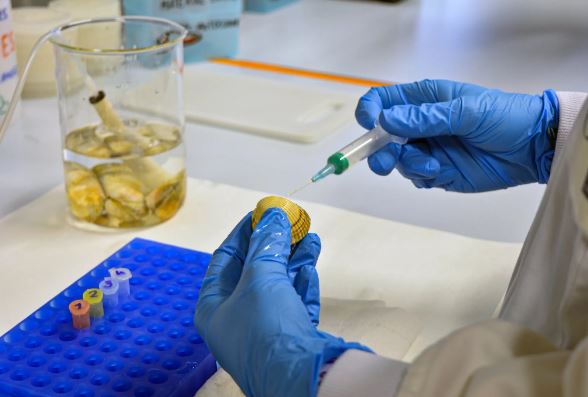There was a puzzling decline in the population of soft-shell clams in Maine and the Chesapeake Bay beginning in the 1970s. Scientists didn’t know what had happened for years, but eventually they narrowed it down to a strange cancer that had spread like wildfire.
Cancer develops when a person’s own cells acquire mutations and proliferate uncontrollably. However, the clams were being colonised by cells that had broken loose from their hosts. Within its new host, the alien cancer cell proliferated, and eventually some of its offspring spread to other clams.
It turns out that the infectious cancer affects other types of shellfish as well. In addition, scientists have discovered that these cancer cell lineages have been spreading from one mussel to another for hundreds of years, if not thousands.
In 2015, scientists analysed fragments of DNA from cancer cells isolated from Canadian, Maine, and New York soft-shell clams. The genetic testing proved that the cancer cells did not originate from the animals originally thought to have produced them. Instead, they shared a common ancestor and were thus all connected.
Before that time, scientists had only discovered canine and Tasmanian devil tumours to be communicable to other mammals.
Tumours on a Tasmanian devil’s face are caused by cancer. Animals can spread cancer cells to one another through bites during fights and mating. Ninety percent of the species died extinct due to the sickness.
In contrast, dogs can develop a benign cancer that spreads mostly through sexual activity. The cells develop in a ring around the genitalia, and the dogs’ immune systems usually clear out the foreign bodies within a few weeks.
Contagious malignancies were first discovered in soft-shell clams, prompting a search in other shellfish. Eight other species, including mussels and cockles, have had their infectious cancers described in scientific literature.
Dr. Metzger and his team have spent the last few years trying to make a comprehensive list of all the mutations that have occurred since the cancer cells became contagious after leaving the original clam. Similar research was conducted by Dr. Baez-Ortega and his colleagues on the Atlantic coast of Europe, home of the common cockle.
Researchers sequenced not only little pieces of DNA from cancer cells, but the full genomes of both the animals and humans. To identify the thousands of mutations responsible for the spread of these tumours, researchers compared DNA from healthy and malignant cells taken from the same animal.
Some forms of cancer cells shared a mutation that was absent in others. That structure, like the branches of a tree, showed how each group’s ancestry traced back to a common progenitor. Dr. Metzger’s group discovered that the tree in the soft-shell clams has two branches, one going to cancer cells near Prince Edward Island and the other to those located off the coast of the Northeastern United States.
To determine how long ago the ancestor cancer cell first became independent, Dr. Metzger and his team examined the amount of mutations that had accumulated in the various branches. According to their calculations, it probably spread for the first time more than two centuries ago.
Cockle malignancies are equally ancient, Dr. Baez-Ortega and his colleagues found, but they were unable to provide an estimate. “They are probably thousands of years old,” he speculated.
It is believed that a mutant immune cell was the initial cause of cancer in both species. The dead cells floated away and were picked up by another mussel, where they multiplied malignantly once more. Over time, the cancer cells mutated to the point where they could float around in the water for months before attaching themselves to a new host.
Cancer DNA has altered little over time, according to studies conducted on Tasmanian devils and dogs. In the case of Tasmanian devils, where the cancer was likely acquired within the last 40 years, this discovery is not all that shocking. However, canine cancer was acquired about the year 11,000 AD. However, over that period of time, the cancer cells have only made minor changes to their genomes.
In contrast, cancer cells in clams and cockles have undergone recurrent cycles of profound transformation. Some cancer cells acquired additional chromosomes, sometimes hundreds. Large chunks of DNA have been lost by some. Sometimes a full copy of the genome is made.
Non-participating evolutionary ecologist Beata Ujvari from Australia’s Deakin University suggested that the rapid mutation rate might be due to the tumours’ highly infectious mode of reproduction. Cancer cells clone themselves rather than merging two separate sets of DNA, as in a shellfish egg and sperm.
They’ve evolved into something more akin to bacteria than a mammal. Dr. Ujvari speculated that cancer cells, like bacteria, would strive to gain an advantage over their rivals by rapidly undergoing mutations. She mentioned that recent research on cockles showed that a single animal can occasionally be infected with two separate types of infectious cancer.
Dr. Metzger believes that if this mystery can be solved, scientists may be able to learn universal truths about cancer that apply not only to humans but also to shellfish.
The small number of altered cancer cell genomes may provide new opportunities for therapeutic discovery. He is also studying the genomes of shellfish for any indication that they have developed a resistance to the disease.

